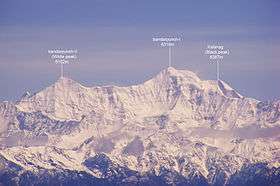Bandarpunch
| Bandarpunch | |
|---|---|
 | |
| Highest point | |
| Elevation | 6,316 m (20,722 ft) |
| Listing | List of mountains in India |
| Coordinates | 31°00′28″N 78°55′33″E / 31.00778°N 78.92583°ECoordinates: 31°00′28″N 78°55′33″E / 31.00778°N 78.92583°E |
| Geography | |
 Bandarpunch Location in northern India | |
| Location | Uttarakhand, India |
| Parent range | Garhwal Himalayas |
Bandarpunch is a mountain massif of the Garhwal division of the Himalayas, in the Indian state of Uttarakhand. Widely known as Bandarpoonch, which literally means "Tail of the monkey". This is a reference to Hanuman, the monkey god and mighty warrior, who went to its summit to extinguish his tail when it caught fire in the battle alongside King Rama to rescue the Princes Sita from the evil forces of the demon Ravana in Lanka. Bandarpoonch massif has 3 peaks. To the west above Yamnotri is White Peak (6102 m). Almost 5 km east is Bandarpoonch Peak (6316 m) and about 4 km to the north-east of that is Kalanag (6387 m) lit. black serpent, commonly known as Black Peak.
Bandarpunch is strategically located at the western edge of the High Himalayan Range where it turns the corner to the northwest. It is part of the Sankari Range and lies within the Govind Pashu Vihar National Park and Sanctuary. It is a major watershed for the headwaters of the Yamuna River, whose source lies above Yamnotri, on the west end of the massif below White Peak. Yamnotri is the westernmost of the four most sacred pilgrimage places (char dham) and destination for thousands of pilgrims annually. On the north side of the Bandapoonch massif, the 12 km long glacier from its flanks feeds the Ruinsar Gad which flows into the Yamuna at Seema. On the south side, the glacier at the base of Bandarpoonch peak feeds the Hanuman Ganga River which joins the Yamuna at Hanuman Chatti.
Maj Gen Harold Williams led the first successful climbing expedition in 1950.[1] The first team to summit Bandarpoonch Peak comprised legendary Mountaineer Tenzing Norgay, Sergeant Roy Greenwood and Sherpa Kin Chok Tshering.[2][3]
See also
References
- ↑ http://mod.nic.in/samachar/nov1-03/html/ch5.htm
- ↑ Man of Everest - The Autobiography of Tenzing Norgay - James Ramsey Ullman - published 1955
- ↑ Ralph Izzard (2007). An Innocent On Everest. Harrison Press. ISBN 978-1-4067-1491-3.